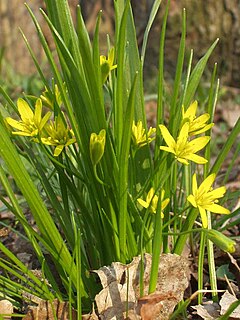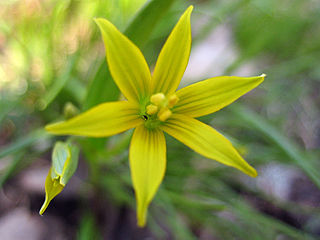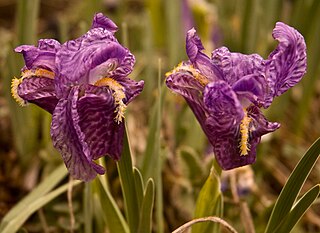
Gagea is a large genus of spring flowers in the lily family. It is found primarily in Eurasia with a few species extending into North Africa and North America.

Gagea lutea, known as the yellow star-of-Bethlehem, is a Eurasian flowering plant species in the family Liliaceae. It is widespread in central Europe with scattered populations in Great Britain, Spain, and Norway to Siberia and Japan.

Falconeria is a monotypic plant genus in the family Euphorbiaceae, first described as a genus in 1839. The genus is sometimes included within the genus Sapium. The sole species is Falconeria insignis. The plant is found from India, Nepal, Bangladesh, and Sri Lanka to Indochina, China, Thailand and Peninsular Malaysia.

John Forbes Royle, British botanist and teacher of materia medica, was born in Kanpur in 1798. He was in charge of the botanical garden at Saharanpur and played a role in the development of economic botany in India.

Gagea bohemica, the early star-of-Bethlehem or Radnor lily, is a European and Mediterranean species of flowering plant in the lily family. It is sometimes referred to as the Welsh Star-of-Bethlehem.

Cardiopteridaceae is a eudicot family of flowering plants. It consists of about 43 species of trees, shrubs, and woody vines, mostly of the tropics, but with a few in temperate regions. It contains six genera, the largest of which is Citronella, with 21 species. The other genera are much smaller.

Notholirion is a small Asian genus of bulbous plants in the lily family. It is closely related to Lilium, but each individual flowers only once, and then dies after producing offsets. The bulb is covered by a tunic. Leaves are basal, produced in autumn and winter.

Gagea minima is a Eurasian species of plants in the lily family.
Gaultheria trichophylla, commonly known as Himalayan snowberry, is a species of plant in the heath and heather family, native to the Himalayas. The flowers range in color from red, to pink, to white; fruits are blue-colored berries; and leaves are approximately 3 mm (0.12 in) in length.

Murdannia is a genus of annual or perennial monocotyledonous flowering plants in the dayflower family.

Maxim Gauci, born Massimo Gauci, was a Maltese lithographer who was active in the United Kingdom in the 19th century. He was an early exponent of lithography for botanical illustration.

The taxonomy of Liliaceae has had a complex history since the first description of this flowering plant family in the mid-eighteenth century. Originally, the Liliaceae or Lily family were defined as having a "calix" (perianth) of six equal-coloured parts, six stamens, a single style, and a superior, three-chambered (trilocular) ovary turning into a capsule fruit at maturity. The taxonomic circumscription of the family Liliaceae progressively expanded until it became the largest plant family and also extremely diverse, being somewhat arbitrarily defined as all species of plants with six tepals and a superior ovary. It eventually came to encompass about 300 genera and 4,500 species, and was thus a "catch-all" and hence paraphyletic taxon. Only since the more modern taxonomic systems developed by the Angiosperm Phylogeny Group (APG) and based on phylogenetic principles, has it been possible to identify the many separate taxonomic groupings within the original family and redistribute them, leaving a relatively small core as the modern family Liliaceae, with fifteen genera and 600 species.
Cardiopteris is a genus of vines in the family Cardiopteridaceae described as a genus in 1834.
Gagea bulbifera is a Eurasian species of plants in the lily family, widespread from Romania to Xinjiang. It is native to Romania, Russia, South Caucasus, Kazakhstan, Kyrgyzstan, Iran, Turkey, Xinjiang, Western Himalayas.
Gagea olgae is an Asian species of plants in the lily family. It is native to Iran, Pakistan, Afghanistan, Kyrgyzstan, Tajikistan, Uzbekistan, Kazakhstan, and Xinjiang.
Gagea pauciflora is an Asian species of plants in the lily family. It is native to Mongolia, Russia, and China.
Gagea tenera is an Asian species of flowering plants in the lily family. It is native to Xinjiang, Central Asia, the Western Himalayas, Iran, Turkey, and South Caucasus.
Gagea flavonutans is an Asian species of plants in the lily family, native to Tibet, Nepal, Sikkim, Bhutan, and Assam.
Gagea dubia is a Mediterranean species of plants in the lily family. It is native to Morocco, Spain, France, Sardinia, Sicily, Greece including Crete, Turkey, Syria, Lebanon, and Iran.

Iris kemaonensis, the Kumaon iris, is a plant species in the genus Iris, it is also in the subgenus Iris and in the section Pseudoregelia. It is a rhizomatous perennial, from Tibetan China, Bhutan, India, Kashmir and Nepal. It has light green or yellowish green leaves, that extend after flowering time. It has a short stem, 1–2 fragrant flowers that are purple, lilac, lilac-purple or pale purple. They also have darker coloured blotches or spots. It is cultivated as an ornamental plant in temperate regions. It is often known as Iris kumaonensis, due to a publishing error.











